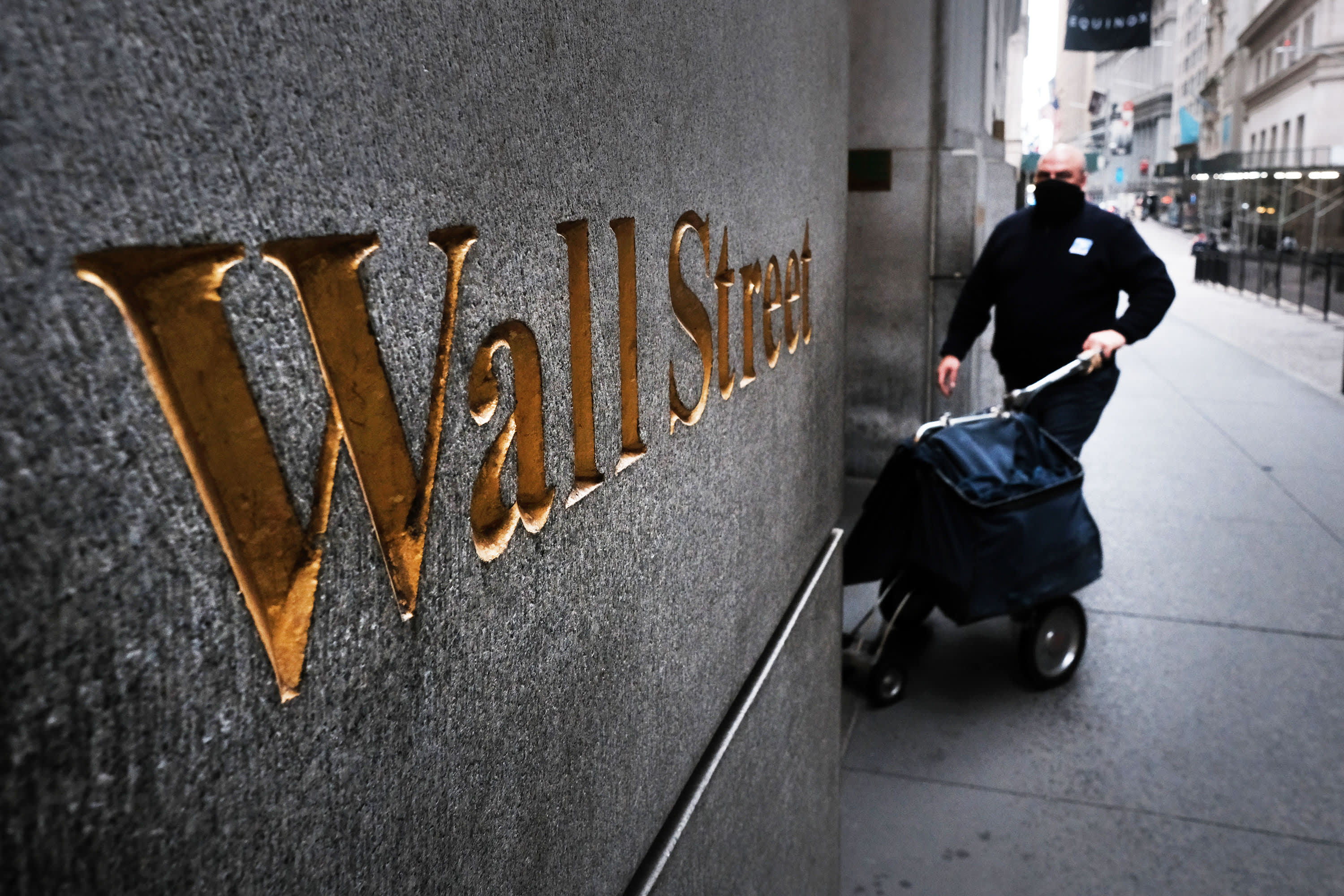People walk by the New York Stock Exchange (NYSE) in lower Manhattan on October 02, 2020 in New York City.
Spencer Platt | Getty Images
The markets are coiling and compressing as they process jarring events and political suspense, with potential energy building up for eventual release.
The stock market has been vibrating within a tight range for a month, an agitated stasis that was not disturbed last week by news of President Donald Trump’s illness or the swings in perceived likelihood of a new thirteen-figure fiscal support deal.
The S&P 500 has been corralled between 3200 and 3400 for four weeks. Twice last week, overnight index futures twitched lower on headline triggers, after the presidential debate and Trump’s positive Covid test, and each time they bounced from around 3300.
Rallies have become stuck around the index’s 50-day average (now around 3360, less than half a percent above Friday’s close). Bespoke Investment Group calls this “a classic sign of a coiling market, and the fact that the S&P 500 recently broke up and out of a bull flag formation would suggest that the resolution will be higher when the breakout comes.”
It’s a cliché that “markets hate uncertainty,” but this is both redundant and incomplete. Uncertainty is the essential state of the world, whether it’s obvious or not. When many important uncertainties are on the surface and are being debated and fretted over constantly, they have a lower capacity to shock and drive a major market repricing.
This helps explain last week’s relative calm and the S&P’s ability to log its first weekly gain since August. Wall Street was already assimilating the prospect of a change in the administration for months. Same with the stimulus back-and-forth. Hedgers have been paying premium prices to protect against volatility surrounding the election since the spring.
Few expected calm
The headlines might be dizzying, but few investors were presuming calm. There’s also an argument to be made that the past week’s events could raise the odds of a definitive outcome on or near Election Day, while perhaps making a timely fiscal package — or a larger one under a new administration — a bit more likely. These are not predictions, but the shifting probabilities the market has been chewing through for a while.
Investor positioning and sentiment are now more in balance after the 10% September correction, which punctured trader overconfidence and brought the big, dominant growth stocks part way back to the pack. A weekly gauge of tactical fund-manager positioning from the National Association of Active Investment Managers last week showed middling equity exposure relative to the range of the past two years.
Bond-market volatility has been near record lows for a while now, with the Federal Reserve buying plenty of Treasuries and, especially, mortgage bonds, which removes a lot of interest-rate risk from public portfolios.
Yet here, too, there are stirrings of more decisive movement. Treasuries saw no “safety bid” last week, even with some softer economic data reported. And the 30-year Treasury yield is near a four-month high, closing Friday at 1.49%.
BTIG strategist Julian Emanuel asks, “Can record low Treasury volatility persist? Elevated near-to-medium term risks notwithstanding, pressure on long-end yields is arguably tilted to the upside with another round of fiscal stimulus potentially on the way and sustained elevated deficit spending and the Fed’s pro-inflationary policy pivot and rebuffing of negative rates. If real rates have indeed troughed and begin to move materially higher, equity volatility will likely rise in tandem given their correlation over the past several months.”
Cost-cutting mode to payoff?
Meantime, another source of potential energy is building up on corporate balance sheets. Big companies have mostly gone into cost-cutting and cash-preservation mode since the Covid shutdown, tapping pliant fixed-income markets for record amounts of new, low-cost debt. More than $1.4 trillion in high- and speculative-grade debt was issued in the first three quarters, a good 50% more than in any other year’s first nine months.
Some of this cash is being used simply to keep operating a shutdown-constrained business, such as among cruise lines, hotels, airlines and many retailers. But plenty more is simply “just-in-case” capital raised opportunistically, which in an economy that emerges from Covid pressures would quickly be deployed trough dividends, share buybacks, acquisitions and new spending – by companies that are also scrambling to protect profit margins through layoffs.
Perhaps not a happy arrangement for the real economy and many households, but this crisis has favored capital over labor, likely creating a spring-loaded release of corporate vigor in the coming quarters.
The “readiness-is-all” character of markets, policy and the economy right now doesn’t have a predetermined outcome or direction once the tension is released. The broader trend indicators continue to favor the ultimate continuation of the bull market in risk assets for a while.
Citi’s global bear-market checklist – meant to flare a warning ahead of a deep and long downturn – now shows 7.5 of 18 risk factors flashing red. This still implies price declines should be bought, according to Citi strategists, though there are more alarms now than there were in February. And the U.S.-specific checklist is now at 10 out of 18 red signals.
Modestly reassuring while cognizant of the hazards of a pricey market and a headline-sensitive public.
Seasonal patterns are unfriendly for another week or so, though tend to offer a more positive message later in October. The market never fully got oversold or panicky enough in September to create a powerful contrarian buy signal. But that, in itself, doesn’t invite more downside pressure.
Fourth-quarter rally attempts are not specific to years when the news is easy to digest and investors comfortable with the path ahead. And, as noted, elections are rarely make-or-break events for an entire cycle and most of what markets want out of an election is for it to be over.
